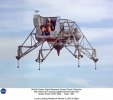TheBubba said:Re-engine the B-52... that's a good use for it. Would cut the number of engines from 8 to 4, maybe possibly 2? I can see that happening. Less fuel + longer range + less engines = better aircraft.
But alas, that would make sense, and we all know that if the military did anything that made sense, it's instantaneously mink out of existance and be replaced by something even more bizzare and inexplicable... (does anyone get the reference?)
You know that does make sense - re-engining the B-52 like that. I doubt we will ever not have B-52's in the inventory.

